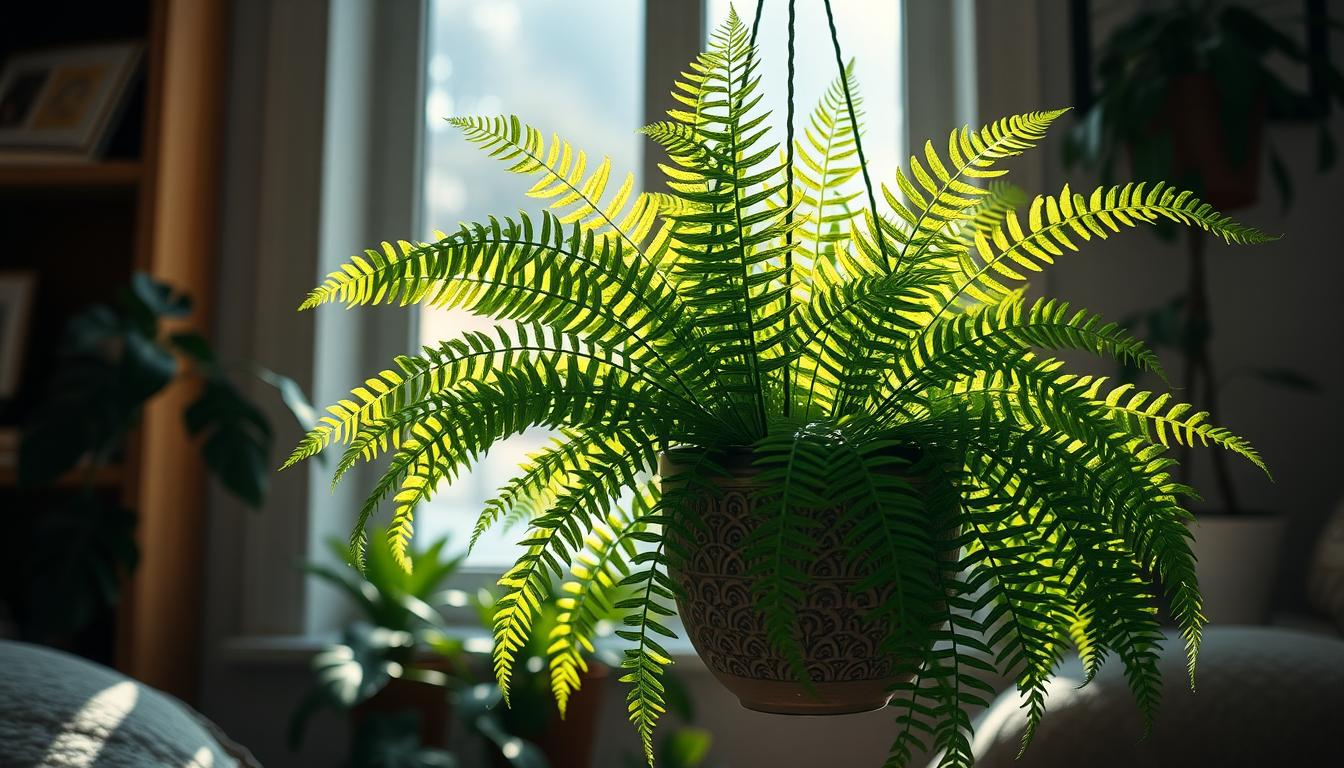Thinking about getting a Boston fern? You want to know how to care for it so it grows well. These plants add beauty to any room and clean the air. They’re safe for pets and make the air healthier.
To keep your Boston fern happy, know what it likes. It needs the right temperature, humidity, and light. With good care, your fern will be a lovely addition to your space.
Understanding the Boston Fern and Its Benefits
The Boston Fern is a favorite for indoor decor. It’s known for its sleek, leafy look. It also purifies the air, making it healthier.
It’s an air-purifying plant. It can clean the air from pollutants. This makes the air cleaner and healthier to breathe.
The Boston Fern has many benefits. It can lower carbon dioxide and other pollutants. It also helps with breathing and can make air feel less dry.
It can even help reduce stress. Plus, it’s easy to take care of. This makes it perfect for beginners.
The Boston Fern can grow really tall, up to 7 feet. Its fronds can be up to 4 feet long and 6 inches wide. It likes cooler nights and warmer days, but not too hot.
It’s great for indoor decor. It can grow well in many places indoors.
Here are some key facts about the Boston Fern:
- It can absorb and filter indoor air pollutants, such as formaldehyde and xylene.
- It can help to reduce stress levels and improve overall indoor comfort.
- It prefers consistent moisture, but can tolerate some drought.
- It is relatively easy to care for, making it a great choice for beginners.
Ideal Growing Conditions for Boston Ferns
To make your Boston Fern happy, you need to know what it likes. It doesn’t like direct sunlight. Instead, give it bright light that’s filtered. The best temperature is between 65-75°F, and it loves humidity over 60%.
To get these conditions right at home, you can use a humidifier. You can also put the fern on a tray with water and pebbles. This helps keep the air moist. Make sure the fern is not too close to cold or hot spots.
- Keep the temperature steady to keep your fern happy.
- Check the humidity often to keep it just right.
- Give your fern bright, filtered light to help it grow well.
By following these tips, you can make a great home for your Boston Fern. This will help it grow strong and healthy.
Watering Your Boston Fern Correctly
Watering your Boston Fern right is key to its health. Too much water can cause root rot. Not enough water can make leaves turn yellow and fall off. Knowing the signs of too much or too little water is important.
Too much water shows as soft and discolored leaves and a bad smell from the soil. Not enough water makes leaves wilt or turn yellow. Water your Boston Fern every 7-10 days, depending on the soil.
Here are some tips for watering your Boston Fern:
- Check the soil moisture by sticking your finger into the soil up to the first knuckle
- Water your Boston Fern when the top inch of soil feels dry
- Avoid getting water on the leaves to prevent fungal diseases
Follow these tips to make sure your Boston Fern gets the right water. Watch your plant and change your watering schedule as needed.
| Watering Frequency | Soil Condition |
|---|---|
| Every 7-10 days | Maintain moist but not soggy soil |
Choosing the Right Soil for Boston Ferns
Choosing the right soil is key for your Boston fern. It should drain well to avoid root rot. A good mix holds moisture but drains well.
A mix of peat moss, perlite, and compost is great for Boston ferns. It keeps the soil moist and drains well. This mix is perfect for your fern to grow.
Recommended Soil Types
Soil for ferns should be slightly acidic, with a pH of 5 to 5.5. Peat moss or coconut coir makes the soil acidic and holds moisture. Perlite or coarse sand helps with drainage.

Importance of Soil Drainage
Soil drainage is very important for your Boston fern. Without it, the soil can get too wet. This can cause root rot and other problems. A well-draining soil mix keeps your fern healthy.
Amendments for Best Results
Adding amendments can help your Boston fern grow well. Worm castings add nutrients. With the right soil and care, your fern will thrive.
Fertilization Strategies for Healthy Growth
Timing is key for Boston Fern fertilization. Fertilize your ferns twice a year during the growing season. Use a balanced liquid fertilizer to give them the nutrients they need.
Choosing the right fertilizer is important. Organic fertilizers are good for Boston Ferns. They release nutrients slowly and don’t burn the leaves. Compost tea or fish emulsion are good choices.
- Use a balanced fertilizer with an NPK ratio of 10-10-10.
- Fertilize once a month during the growing season.
- Avoid over-fertilization, which can cause leaf burn, stunted growth, and yellowing leaves.
Follow these tips and choose the right fertilizers. This will help your Boston Ferns grow well and stay healthy.
Pruning and Grooming Your Boston Fern
As you care for your Boston fern, pruning techniques are key. They keep your plant healthy and looking good. You should prune your fern regularly to keep it full and lush.
Pruning is best in spring or summer. It means cutting off dead fronds and trimming long stems. This keeps your fern looking great.
Grooming ferns is important too. You need to know when and how to prune. Also, how to remove dead fronds without hurting your plant.
- Prune your Boston fern every 2 to 3 years to keep it healthy and full.
- Remove dead or damaged fronds to prevent the spread of disease and encourage new growth.
- Trim back overgrown stems to maintain the desired shape and size of your plant.
| Pruning Frequency | Best Time | Benefits |
|---|---|---|
| Every 2 to 3 years | Spring or summer | Promotes healthy growth, maintains appearance |
Using these pruning techniques will make your Boston fern thrive. It will be lush and beautiful. Remember, regular Boston Fern pruning and grooming ferns keep your plant happy and healthy.
Pest and Disease Management
When you take care of your Boston fern, watch out for pests and diseases. They can harm your plant. Regular checks and quick action help keep your fern healthy and green.
Spider mites, mealybugs, and scale insects are common problems. To fight them, check your plant often. Also, keep new plants separate. Use insecticidal soap or neem oil if needed.
Common Pests to Watch For
- Spider mites
- Mealybugs
- Scale insects
Signs of Disease
Root rot and leaf spot are diseases that can hurt your fern. They often come from too much water. Look for yellow leaves, soft stems, and black spots.
Prevention Tips
To avoid pests and diseases, water carefully and air well. Also, fertilize right. Being proactive keeps your Boston fern healthy and pest-free.
Propagating Your Boston Fern
Exploring Boston Fern propagation reveals many methods. You can use division of roots, division of runners, or spore propagation. Timing and techniques are key for success. Choose the best time and method for you.
Division of roots and runners are easy. But spore propagation is more complex. For success, pick healthy plants and give new ones the right care. Use well-draining soil and keep moisture consistent.
Methods for Propagation
- Division of the roots: This method involves dividing the root ball of a mature Boston Fern into smaller sections, each with its own roots and fronds.
- Division of the runners: This method involves cutting the runners (stolons) from a mature Boston Fern and potting them up to create new plants.
- Spore propagation: This method involves collecting spores from mature fronds and sowing them in a controlled environment.
Caring for new ferns is crucial. They need the right light, water, and nutrients. With patience and the right methods, you can grow your Boston Fern.

Caring for Baby Ferns
After propagating, new ferns need the right care. Keep them moist, provide indirect light, and fertilize often. Follow these tips and enjoy your Boston Ferns for years.
| Propagation Method | Success Rate | Level of Difficulty |
|---|---|---|
| Division of the roots | High | Easy |
| Division of the runners | Medium | Medium |
| Spore propagation | Low | Challenging |
Seasonal Care Tips
As you care for your Boston Fern, think about the seasons. Each season changes your plant’s needs. You need to adjust your care to keep your fern healthy all year.
In winter, your fern needs less water. It grows slower and doesn’t need as much moisture. Cut back on watering to half what you do in summer. This keeps your fern healthy until spring.
In summer, make the air around your fern more humid. You can use a tray with water and pebbles. This creates a humid microclimate. Also, water your fern more often because it grows faster in warm weather.
Some extra summer tips include:
- Keep the soil moist
- Fertilize monthly with a nitrogen-rich fertilizer
- Prune old or damaged fronds to encourage new growth
Adjusting your care to the seasons helps your fern grow well. Remember, seasonal care is key to a happy, thriving fern.
Repotting Your Boston Fern
As your Boston fern grows, it will need a new home. This is called repotting Boston Ferns. It’s important to do this when the fern is ready. Spring is the best time because the fern is most active then.
When you repot, pick a pot that’s just a bit bigger. A pot that’s too big can cause problems. Learn more about repotting Boston ferns and their needs.
After repotting, watch your fern closely. Signs of trouble include yellow leaves or wilting. If your fern is struggling, check out how to revive a dying houseplant.
Here are some important tips for repotting your Boston fern:
- Choose a pot that is slightly larger than the current one.
- Use a well-draining potting mix to prevent root rot.
- Water carefully, as overwatering can be detrimental.
Troubleshooting Common Boston Fern Issues
Boston Ferns are easy to care for, but sometimes you might seeyellowing leaves or leaf drop. Don’t worry, these problems can be fixed with the right steps.
Yellow leaves mean you might be watering too much or not enough light. Change how often you water and make sure it gets 2 hours of indirect sunlight a day. Leaf drop happens if the plant is too dry or the air is too dry. Water more often and use a pebble tray or mist to make the air wetter.
Keeping your Boston Fern happy and healthy is all about good care. Watch for problems and fix them fast. This way, you can enjoy its beauty and air-purifying benefits for many years.
To Read more about the many popular varieties of houseplants check out our guide of the 100 best houseplants.





Pingback: 10 Best Low-Light Houseplants for a Lush Indoor Oasis - Trusted House Plant Guide